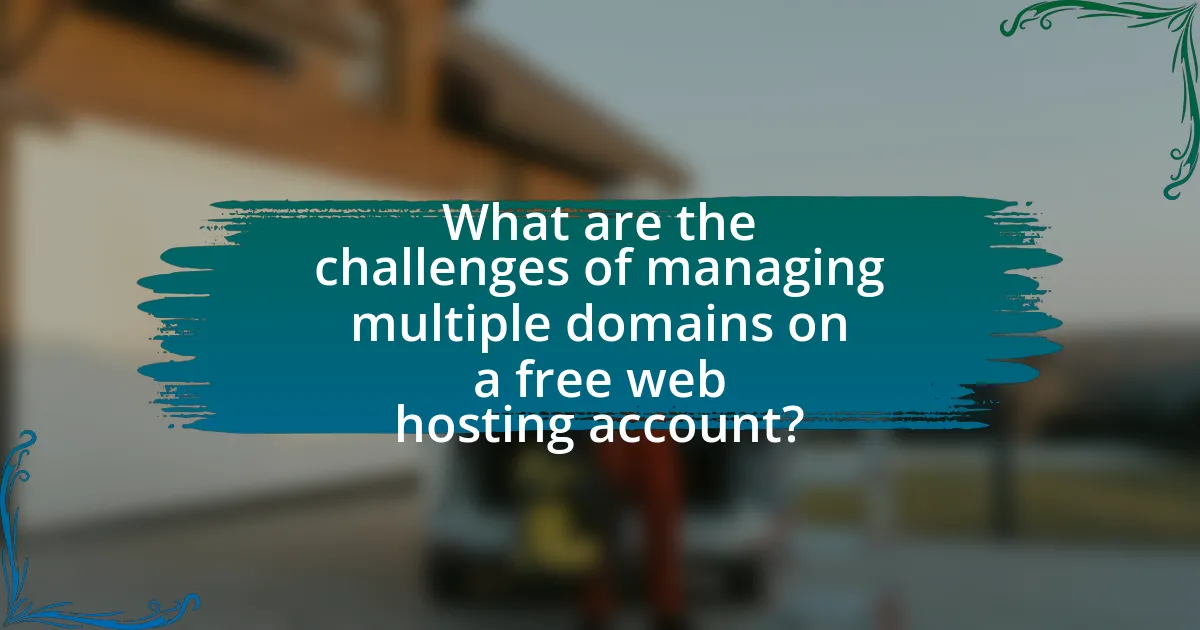The article focuses on the challenges and strategies for managing multiple domains on a free web hosting account. It highlights the limitations imposed by free hosting services, such as restricted bandwidth, lack of technical support, and minimal domain management features, which can lead to operational inefficiencies and performance issues. Key topics include common problems like domain name conflicts and DNS management complexities, as well as practical tips for optimizing domain management, ensuring security, and enhancing website performance. The article also discusses tools and best practices that can facilitate effective management of multiple domains within the constraints of a free hosting environment.

What are the challenges of managing multiple domains on a free web hosting account?
Managing multiple domains on a free web hosting account presents several challenges, including limited resources, lack of technical support, and potential downtime. Free web hosting services often impose restrictions on bandwidth, storage, and server performance, which can hinder the ability to effectively manage multiple domains. Additionally, these services typically offer minimal customer support, making it difficult to resolve issues that arise with domain management. Furthermore, free hosting accounts may experience frequent downtime or slower loading speeds, negatively impacting user experience across all managed domains. These factors collectively complicate the management of multiple domains, leading to potential operational inefficiencies.
How does a free web hosting account limit domain management?
A free web hosting account limits domain management by restricting the number of domains that can be hosted and often lacking advanced features such as DNS management. Typically, these accounts allow only a single domain or subdomain, which hinders users from managing multiple domains effectively. Additionally, free hosting services may impose limitations on domain forwarding, email accounts associated with the domain, and the ability to connect custom domains, further constraining users’ options for domain management.
What specific restrictions do free web hosting accounts impose on domains?
Free web hosting accounts typically impose restrictions on domains such as limited domain name options, lack of custom domain support, and mandatory subdomains. Many free hosting services only allow users to host their websites on subdomains of the provider’s main domain, which can affect branding and professionalism. Additionally, some free hosting platforms may restrict the number of domains that can be linked to a single account, often capping it at one or two. These limitations can hinder the ability to manage multiple domains effectively, as users may need to upgrade to paid plans for full domain functionality and flexibility.
How can these limitations affect website performance and functionality?
Limitations in free web hosting accounts can significantly degrade website performance and functionality. These limitations often include restricted bandwidth, limited storage space, and lack of technical support, which can lead to slow loading times, frequent downtime, and an inability to handle high traffic volumes. For instance, a study by Google found that a one-second delay in page load time can result in a 20% decrease in conversions, highlighting the critical impact of performance on user engagement. Additionally, the absence of technical support can hinder timely resolution of issues, further compromising website reliability and user experience.
What common issues arise when managing multiple domains?
Common issues that arise when managing multiple domains include domain name conflicts, DNS management complexities, and inconsistent branding. Domain name conflicts occur when multiple domains are registered with similar names, leading to confusion among users. DNS management complexities arise from the need to configure and maintain multiple DNS records, which can lead to misconfigurations and downtime if not handled properly. Inconsistent branding happens when different domains are not aligned in terms of design and messaging, which can dilute brand identity and confuse customers. These issues highlight the importance of careful planning and organization when managing multiple domains.
How can domain name conflicts be resolved?
Domain name conflicts can be resolved through a combination of negotiation, legal action, and the use of dispute resolution policies. First, parties involved in the conflict should attempt to negotiate a settlement, which may involve one party agreeing to relinquish the domain name or reach a licensing agreement. If negotiation fails, legal action can be pursued under trademark law, where the party claiming rights to the name can file a lawsuit to assert their claim. Additionally, many domain registrars and organizations, such as the Internet Corporation for Assigned Names and Numbers (ICANN), offer dispute resolution policies like the Uniform Domain Name Dispute Resolution Policy (UDRP), which provides a structured process for resolving conflicts based on established criteria. These methods are effective as they provide clear pathways for resolution based on legal frameworks and established policies.
What are the implications of bandwidth limitations on multiple domains?
Bandwidth limitations on multiple domains can lead to reduced website performance, slower loading times, and potential downtime. When multiple domains share a limited bandwidth, the available data transfer capacity is divided among them, which can result in congestion during peak usage times. For instance, if a free web hosting account allocates 1 GB of bandwidth per month and hosts five domains, each domain may only effectively utilize 200 MB, leading to slower response times and user dissatisfaction. Additionally, exceeding bandwidth limits can trigger throttling or temporary suspension of services, impacting accessibility and user experience across all domains hosted on that account.

How can you effectively manage multiple domains on a free web hosting account?
To effectively manage multiple domains on a free web hosting account, utilize a control panel that supports domain management features. Many free hosting services offer control panels like cPanel or similar interfaces, allowing users to add and manage multiple domains under a single account. This functionality typically includes options for DNS settings, email accounts, and file management for each domain, enabling streamlined operations. Additionally, ensure that the hosting provider allows for sufficient bandwidth and storage to accommodate all domains, as limitations can hinder performance.
What strategies can be employed for efficient domain management?
Efficient domain management can be achieved through several strategies, including centralized management tools, regular audits, and clear documentation. Centralized management tools, such as domain registrars that offer bulk management features, allow users to oversee multiple domains from a single interface, streamlining updates and renewals. Regular audits help identify unused or underperforming domains, enabling informed decisions about retention or cancellation. Clear documentation of domain settings, renewal dates, and associated services ensures that all relevant information is easily accessible, reducing the risk of lapses in service. These strategies collectively enhance organization and efficiency in managing multiple domains.
How can you prioritize which domains to manage first?
To prioritize which domains to manage first, assess their traffic, revenue potential, and renewal dates. Domains generating higher traffic and revenue should be prioritized for management to maximize returns, while those nearing renewal should be addressed to avoid lapses. For instance, a domain with consistent monthly traffic of 1,000 visitors and generating $100 in monthly revenue should take precedence over a domain with minimal traffic and no revenue. This approach ensures efficient resource allocation and minimizes risks associated with domain expiration.
What tools can assist in managing multiple domains effectively?
Tools that can assist in managing multiple domains effectively include domain management platforms like GoDaddy, Namecheap, and Google Domains. These platforms provide centralized dashboards for domain registration, DNS management, and renewal notifications, streamlining the process of overseeing multiple domains. For instance, GoDaddy offers bulk domain management features that allow users to edit settings for multiple domains simultaneously, enhancing efficiency. Additionally, tools like cPanel and Plesk facilitate domain management by providing user-friendly interfaces for managing hosting settings, email accounts, and databases associated with each domain. These tools are widely recognized for their effectiveness in simplifying the complexities of managing multiple domains.
How can you optimize your free web hosting account for multiple domains?
To optimize your free web hosting account for multiple domains, utilize a single control panel to manage all domains efficiently. This approach allows for streamlined updates, easier DNS management, and centralized resource allocation. Many free hosting services provide a control panel that supports multiple domains, enabling users to configure settings like email forwarding and subdomains without needing separate accounts. Additionally, ensure that your hosting plan supports the number of domains you intend to manage, as some free services may impose limits. By consolidating management tasks and confirming compatibility with your hosting provider, you can enhance performance and reduce administrative overhead.
What settings should be adjusted for better performance?
To achieve better performance when managing multiple domains on a free web hosting account, adjust the server resource allocation settings. Specifically, increase the allocated memory and CPU limits if the hosting provider allows it, as these adjustments can enhance the speed and responsiveness of your websites. Additionally, optimize caching settings to reduce load times, and ensure that database connections are efficiently managed to prevent bottlenecks. These adjustments are supported by performance metrics indicating that higher resource allocation directly correlates with improved website loading speeds and user experience.
How can you utilize subdomains to enhance management?
Utilizing subdomains enhances management by allowing the organization of content and services under a single domain, which simplifies navigation and administration. For instance, a business can create subdomains like blog.example.com or shop.example.com to separate different functions, making it easier to manage specific areas without the need for multiple hosting accounts. This structure not only improves user experience by providing clear pathways to various services but also streamlines administrative tasks, as updates and maintenance can be handled within the same hosting environment. Additionally, subdomains can improve SEO by targeting specific keywords relevant to each section, thereby increasing visibility and traffic.

What best practices should be followed when managing multiple domains?
When managing multiple domains, it is essential to implement a structured approach to ensure efficiency and security. First, centralize domain management by using a single registrar for all domains, which simplifies renewals and updates. Additionally, maintain a clear naming convention for domains to easily identify their purpose and ownership. Regularly update contact information and DNS settings to prevent service interruptions. Utilize domain forwarding and subdomains strategically to enhance organization and user experience. Finally, monitor domain expiration dates and set up reminders to avoid losing any domains. These practices help streamline management and reduce the risk of errors, ensuring that all domains function effectively.
How can you ensure security across multiple domains?
To ensure security across multiple domains, implement a centralized security management system that enforces consistent security policies across all domains. This system should include features such as SSL certificates for each domain, regular software updates, and strong password policies to protect against unauthorized access. Additionally, utilizing a web application firewall (WAF) can help monitor and filter traffic to prevent attacks. According to a report by the Ponemon Institute, organizations that implement centralized security measures reduce the risk of data breaches by up to 30%.
What measures can be taken to protect against domain hijacking?
To protect against domain hijacking, implement domain locking, which prevents unauthorized transfers. Domain registrars offer this feature, ensuring that any transfer request must be verified by the domain owner. Additionally, enable two-factor authentication (2FA) on your registrar account to add an extra layer of security, as it requires a second form of verification beyond just a password. Regularly monitor your domain’s registration details and set up alerts for any changes to detect unauthorized access promptly. According to a report by the Internet Corporation for Assigned Names and Numbers (ICANN), domains with these security measures are significantly less likely to be hijacked.
How can SSL certificates be managed for multiple domains?
SSL certificates for multiple domains can be managed using a multi-domain SSL certificate or a wildcard SSL certificate. A multi-domain SSL certificate allows you to secure multiple domain names with a single certificate, simplifying management and reducing costs. For instance, a single multi-domain certificate can cover example.com, example.net, and example.org. Alternatively, a wildcard SSL certificate can secure a primary domain and all its subdomains, such as *.example.com, which covers blog.example.com and shop.example.com. This approach minimizes the number of certificates needed and streamlines the renewal process, as you only need to manage one certificate for multiple domains or subdomains.
What are the common troubleshooting tips for managing multiple domains?
Common troubleshooting tips for managing multiple domains include verifying DNS settings, ensuring proper domain registration, and checking for conflicts in hosting configurations. Verifying DNS settings ensures that each domain points to the correct IP address, which is crucial for accessibility. Proper domain registration confirms that all domains are active and not expired, preventing downtime. Additionally, checking for conflicts in hosting configurations, such as overlapping resource allocations or incorrect server settings, can resolve issues that may arise when managing multiple domains. These steps are essential for maintaining a seamless experience across all domains.
How can you resolve DNS issues effectively?
To resolve DNS issues effectively, first, verify the DNS settings for your domain to ensure they are correctly configured. This includes checking the nameservers, A records, and CNAME records to confirm they point to the correct IP addresses. Additionally, use tools like nslookup or dig to diagnose DNS resolution problems by querying DNS records directly. According to a study by the Internet Systems Consortium, misconfigured DNS settings account for a significant percentage of domain resolution failures, highlighting the importance of accurate configuration.
What steps should be taken if a domain fails to resolve?
If a domain fails to resolve, the first step is to check the domain’s DNS settings to ensure they are correctly configured. This includes verifying that the nameservers are pointing to the correct hosting provider and that the DNS records (A, CNAME, MX, etc.) are properly set up. Next, use a DNS lookup tool to confirm that the DNS records are propagating correctly across the internet. If the settings are correct and the issue persists, clear the local DNS cache on your device and try accessing the domain from different networks to rule out local issues. Additionally, check for any domain registration issues, such as expiration or suspension, by consulting the domain registrar. These steps are essential as DNS misconfigurations are a common cause of domain resolution failures.
What practical tips can enhance your experience managing multiple domains?
To enhance your experience managing multiple domains, utilize a centralized management tool that allows you to oversee all domains from a single interface. This approach simplifies tasks such as DNS management, domain registration, and renewal tracking, reducing the risk of errors and saving time. For instance, platforms like cPanel or Plesk provide user-friendly dashboards that streamline these processes, enabling efficient management of multiple domains. Additionally, setting up automated reminders for renewals and using consistent naming conventions for domain records can further improve organization and prevent lapses in service.


